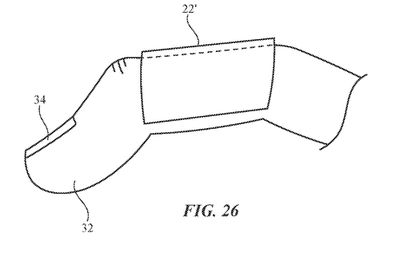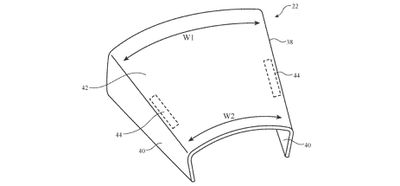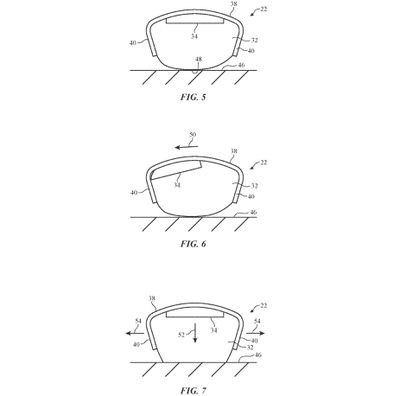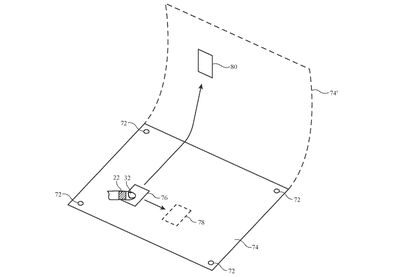Apple is researching a finger-mounted device with an array of sensors and haptic feedback, to be used as a control device for a mixed-reality headset, according to patent filings.

The patent application, first spotted by Patently Apple, was filed with the U.S. Patent and Trademark Office and resurfaced earlier today. Titled "Finger-Mounted Device With Sensors and Haptics," the filing explains how a finger-mounted device can be used to wirelessly control computers and "head-mounted display systems" that are used for "virtual reality content and/or augmented reality content".

The patent filing appears to align with some rumors surrounding the control-input of Apple's long-awaited headset product. A recent report from The Information said that Apple is developing multiple ways to control its mixed reality headset, including a "thimble-like device to be worn on a person's finger."

In the filing, Apple acknowledges that some implementations of a wearable control device could resemble a glove with sensors to detect hand motions, but says that a finger-mounted device has a number of advantages, such as retaining the ability to feel objects in the user's surroundings and maintain comfort.
In terms of design, the device has two small sidewalls to grip a finger using magnets or springs, and can therefore accommodate a range of different finger sizes. It may be "formed from a deformable material such as metal," but the patent also suggests that other materials such as fabric or polymer may be appropriate.

Apple's finger-mounted device is worn on the tops of a user's fingers and leaves fingertips exposed so that it is still possible to touch surfaces as normal.
To allow the user to feel real-world objects accurately, the finger-mounted device may have a U-shaped cross-sectional profile or other shape that allows underside portions of the user's fingertips to be exposed to the environment.
Apple explains that this configuration allows the user to "touch surfaces with the user's own skin, thereby enhancing the user's sensitivity to the environment in which device is being used," giving the example of how a user will be able to "detect small surface imperfections on a touched surface, slight irregularities in surface texture, and other details that might be obscured in a configuration in which the pads of the user's fingers are covered."
The device forms a shell containing force sensors, accelerometers, gyroscopes, optical sensors, touch sensors, status indicator lights, and more. These sensors use capacitive sensing techniques and other methods to precisely ascertain the way in which the user is moving their finger and interacting with surfaces. The system is said to be so precise that it can detect how hard a user is pressing on a surface and the exact direction of this force.
The control circuitry may gather finger press input, lateral finger movement input, and finger tap input using the sensors and may provide haptic output using the haptic output device.

In response to interactions virtualized on the external device, the finger-mounted device can deliver haptic feedback to the user, much like the Apple Watch, to "provide clicks and other haptic output."
For example, the control circuitry may supply haptic output to a user's fingers based on wirelessly received information from the external device. The haptic output may correspond to virtual reality or augmented reality haptic output...
Haptic output may be provided to the user to confirm to the user that a light tap input has been recognized or to otherwise provide feedback to the user. The haptic feedback may provide the user with a sensation of tapping on a physical keyboard or other input device with a movable button member even when the user is tapping on a hard flat surface such as a tabletop. The haptic output provided with the wearable electronic device to the user may be virtual reality haptic output or augmented reality haptic output that is provided while a user is wearing a head-mounted display or other device that creates a virtual reality or augmented reality environment for a user.
In practice, Apple says that this could "provide a user with the sensation of interacting on a physical keyboard when the user is making finger taps on a table surface," in alignment with "a virtual keyboard surface that is being displayed in alignment with the table surface using a head-mounted display." Alternatively, the device may "allow a user to supply joystick-type input using only lateral movement of the user's fingertips" for gaming.

Apple suggests that the device may also be worn "on one or more fingers," but it is not clear what difference this would make to interactions or if Apple expects multiple finger-mounted devices to be worn on a single hand.
The general correspondence of Apple patent applications to recent rumors about Apple's mixed reality headset is clear to see, but whether The Information's "thimble-like" control device is depicted in this patent filing is yet to be seen.
While patent applications cannot be taken as concrete evidence of the exact hardware Apple is planning to sell, it is difficult to look past the way in which the company's recent spate of patent filings may fit into the bigger picture surrounding its AR/VR project.
























